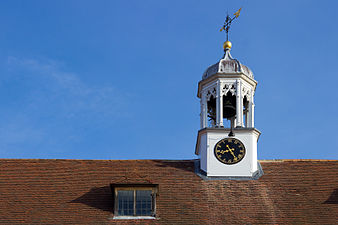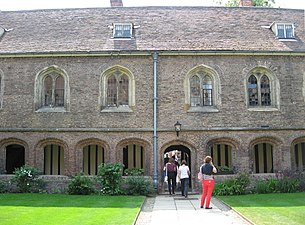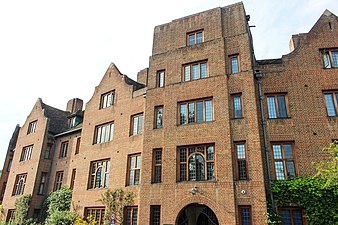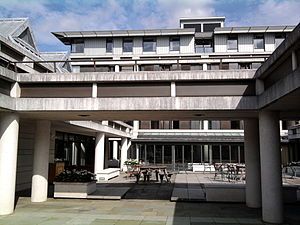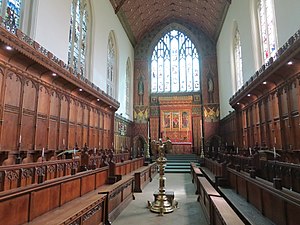Queens' College, Cambridge: Difference between revisions
| Line 79: | Line 79: | ||
The Erasmus Building completes Friar's Court on the West. It was designed by Sir Basil Spence and erected in 1959, and is notable for being the first college building on the Backs to be designed in the Modernist tradition. The modern design of the building generated some controversy and the project encountered strong resistance at the time. It was officially opened by H.M. The Queen Mother in June 1961. The lawn in front includes a crown bowling green laid out in the 16th century. | The Erasmus Building completes Friar's Court on the West. It was designed by Sir Basil Spence and erected in 1959, and is notable for being the first college building on the Backs to be designed in the Modernist tradition. The modern design of the building generated some controversy and the project encountered strong resistance at the time. It was officially opened by H.M. The Queen Mother in June 1961. The lawn in front includes a crown bowling green laid out in the 16th century. | ||
[[File:The Old Chapel, Queens' College, Cambridge.jpg|left|thumb|170px|The Old Chapel in 1872]] | |||
===Cripps Court=== | ===Cripps Court=== | ||
Cripps Court, incorporating Lyon Court (named after the late Queen Mother), was designed by Sir Philip Powell of Powell & Moya and built in stages between 1972 and 1988. In brutalist style it houses a bar and gymnasium with squash courts, 171 student bedrooms, three fellows' flats, a solarium, dining hall and kitchens, various function rooms, a large multipurpose auditorium (The Fitzpatrick Hall) and three combination rooms (Junior for undergraduate students, Middle for postgraduates, and Senior for fellows). It was the benefaction of the Cripps Foundation and the largest building erected by the college. A fourth floor was added in 2007, providing student accommodation and fellows' offices. | Cripps Court, incorporating Lyon Court (named after the late Queen Mother), was designed by Sir Philip Powell of Powell & Moya and built in stages between 1972 and 1988. In brutalist style it houses a bar and gymnasium with squash courts, 171 student bedrooms, three fellows' flats, a solarium, dining hall and kitchens, various function rooms, a large multipurpose auditorium (The Fitzpatrick Hall) and three combination rooms (Junior for undergraduate students, Middle for postgraduates, and Senior for fellows). It was the benefaction of the Cripps Foundation and the largest building erected by the college. A fourth floor was added in 2007, providing student accommodation and fellows' offices. | ||
===The Mathematical Bridge=== | ===The Mathematical Bridge=== | ||
{{main|Mathematical Bridge}} | {{main|Mathematical Bridge}} | ||
[[File:The Mathematical Bridge in Cambridge.jpg| | [[File:The Mathematical Bridge in Cambridge.jpg|right|thumb|200px|The Mathematical Bridge]] | ||
The Mathematical Bridge (officially named ''the Wooden Bridge'') crosses the River Cam and connects the older half of the college (affectionately referred to by students as the "dark side") with the newer western half (the "light side", officially known as "The Island"). It is part of one of the most photographed views in Cambridge; the typical photo being taken from the nearby Silver Street Bridge. | The Mathematical Bridge (officially named ''the Wooden Bridge'') crosses the River Cam and connects the older half of the college (affectionately referred to by students as the "dark side") with the newer western half (the "light side", officially known as "The Island"). It is part of one of the most photographed views in Cambridge; the typical photo being taken from the nearby Silver Street Bridge. | ||
Latest revision as of 19:11, 4 April 2024
| Queens' College
| |||||||||||
|
Floreat Domus | |||||||||||
|---|---|---|---|---|---|---|---|---|---|---|---|
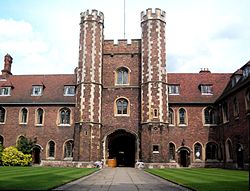 Queens' College Gatehouse | |||||||||||
 | |||||||||||
| President: | Mohamed A. El-Erian | ||||||||||
| Website: | queens.cam.ac.uk | ||||||||||
| |||||||||||
| Location | |||||||||||
| Grid reference: | TL44665819 | ||||||||||
| Location: | 52°12’11"N, -0°6’56"E | ||||||||||
Queens' College is a constituent college of the University of Cambridge.[1] Queens' is one of the 16 "old colleges" of the university, founded in 1448 by Margaret of Anjou. Its buildings span the River Cam with the Mathematical Bridge and Silver Street connecting the two sides.
History

Queens' College was founded in 1448 by Margaret of Anjou, daughter of René of Anjou and Henry VI's queen; it was refounded in 1465 by the rival queen Elizabeth Woodville, wife of Edward IV, who dethroned Henry). This dual foundation is reflected in its orthography: Queens<bold>'</bold>, not Queen's, although the full name is "The Queen's College of St Margaret and St Bernard, commonly called Queens' College, in the University of Cambridge".[2][3]
The arms of the college reflect its foundation – it uses the arms the Duke of Anjou, with a bordure verte as a difference.
In 1446 Andrew Dokett obtained a charter from Henry VI to found St Bernard's College, on a site now part of St Catharine's College. A year later the charter was revoked and Dokett obtained a new charter from the king to found St Bernard's College on the present site of Old Court and Cloister Court. In 1448 Queen Margaret received from her husband, King Henry VI, the lands of St Bernard's College to build a new college to be called "Queen's College of St Margaret and St Bernard". On 15 April 1448, Sir John Wenlock, chamberlain to Queen Margaret, laid the foundation stone at the south-east corner of the chapel.
By 1460 the library, chapel, gatehouse and President's Lodge were completed and the chapel licensed for service. In 1477 and 1484 Richard III made large endowments to the college and his wife, Anne Neville, became the third queen to be patroness of the college, making endowments on her own behalf, which were all taken away by Henry VII after he overthrew Richard. Between that time and the early 1600s, many improvements were made and new buildings constructed, including the Walnut Tree Building, which was completed in 1618. Since then the college has refurbished most of its old buildings and steadily expanded.
In the early 17th century Queens' had become a very fashionable college for the gentry and aristocracy, especially for those with more Puritan leanings.
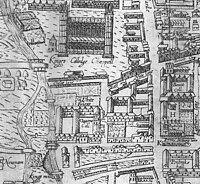
During the Civil War the college sent all its silver to help the King. As a result, the president and the fellows were ejected from their posts. In 1660 the president was restored.
In 1777, a fire in the Walnut Tree Building destroyed the upper floors, which were rebuilt 1778–82. In February 1795 the college was badly flooded, reportedly waist-deep in the cloisters.
In 1823, the spelling of the college's name officially changed from Queen's to Queens'. The earliest known record of the Queens' College Boat Club dates from 1831. In 1862, the college’s debating club, the St Bernard Society, was founded. In 1884, the first football match was played by the college team and the St Margaret Society, the music society, was founded.
In 1980, the college for the first time allowed females to matriculate as members, with the first female members of the college graduating in 1983.[4]
Buildings and location
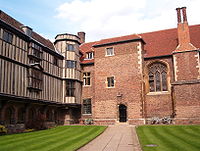
Queens' College has some of the most recognisable buildings in Cambridge. It combines mediæval architecture and modern architecture in extensive gardens. It is one of two Cambridge colleges whose core buildings straddle the River Cam (the other being St John's). The two halves are joined across the river by the Mathematical Bridge. The two banks are colloquially referred to as the "light side" and the "dark side".
Queens' College is located to the south of the centre of the city. It is the second southernmost of the old colleges on the banks of the River Cam, primarily on the east bank. (The others, in distance order northward, are King's, Clare, Trinity Hall, Trinity, St John's, and Magdalene. Only Darwin is to the south on the river.
Cloister Court

The President's Lodge of Queens' is the oldest building on the river at Cambridge (ca. 1460).[5] The President's Lodge is part of Cloister Court: the Cloister walks were erected in the 1490s to connect the Old Court of 1448/9 with the riverside buildings of the 1460s, thus forming the court now known as Cloister Court. Essex Building, in the corner of the court, was erected 1756–60, named after its builder, James Essex the Younger (1722–1784), a local craftsman who had earlier erected the Mathematical Bridge.
Old Court
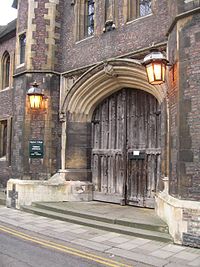
Old Court was built between 1448 and 1451. Stylistic features suggest that this was designed by and built under the direction of the master mason Reginald Ely, who was also at the same time erecting the original Old Court of King's College (now part of the University Old Schools opposite Clare College), and the start of King's College Chapel. Whereas King's was built using very expensive stone, Queens' Old Court was made using cheaper clunch with a red brick skin. Queens' was finished within two years, whereas King's Old Court was never finished, and the chapel took nearly a century to build.
The War Memorial Library is the present student library. The War Memorial Library was formerly the original chapel, part of Old Court. It was named in honour of Queens' College alumni and members who died in service in the Second World War. Before the 1940s, the student library was the present Old Library.
Old Library
The Old Library was built in 1448, part of Old Court, and situated between the President's Lodge and the original chapel. It is one of the earliest purpose-built libraries in Cambridge. It houses a collection of nearly 20,000 manuscripts and printed books. It is especially notable because nearly all printed books remain in their original bindings, because Queens' has never been wealthy enough to afford re-binding all the books in a uniform manner, as was the fashion in the 18th century. It is also notable because it contains the earliest English celestial globes, owned once by Queens' fellow of mathematics Sir Thomas Smith (1513–1577), and because its mediæval lecterns were refashioned into bookshelves, still present today.
Walnut Tree Court

Walnut Tree Court was erected 1616–18. Walnut Tree Building on the east side of the court dates from around 1617 and was the work of the architects Gilbert Wragge and Henry Mason at a cost of £886.9s. Only the ground floor of the original construction remains after a fire in 1777, so it was rebuilt from the first floor upwards between 1778 and 1782, and battlements were added to it in 1823. This court was formerly the site of a Carmelite friary, Cambridge Whitefriars, founded in 1292, but is now the location of the college chapel and various fellows' and students' rooms. The walnut tree in the court stands on the line of a former wall of the friary, and was a replacement of an older one in the same position after which the court was named.
The college chapel in Walnut Tree Court was designed by George Frederick Bodley, built by Rattee and Kett and consecrated in 1891.[6] It follows the traditional college chapel form of an aisle-less nave with rows of pews on either side, following the plan of monasteries, reflecting the origins of many colleges as a place for training priests for the ministry. The triptych of paintings on the altarpiece panel are late-15th-century Netherlandish, and are attributed to the 'Master of the View of Saint Gudula'. They depict, from left to right, the Agony in the Garden of Gethsemane, the Resurrection of Jesus and Christ's Appearance to the Disciples and may originally have been part of a set of five paintings.
Friar's Court

The College experienced a growth in student numbers during the 19th century, bringing with it the need for additional student accommodation. The President's second garden was taken as the site for new student accommodation called Friars' Building, designed by W. M. Fawcett and built in 1886. The building, named after the Cambridge Whitefriars, accommodates 52 students and fellows.
Friars' Building is flanked to the East by the Dokett Building. Dokett Building was designed by Cecil Greenwood Hare and built in 1912 from thin red Daneshill brick with Corsham stone dressings and mullioned windows. It stands on the former site of almshouses which were maintained by benefaction from a former President of the college Andrew Dokett. The almshouses were demolished in 1911 to make way for the new building. On demolition of the almshouses, a fund was made available for payment of pensions – always to eight women — in accordance with the will of Dokett. In 2014, Dokett Building underwent major restorations, with the majority of the bricks in the building being replaced and the rooms being reconfigured. In 2019, railings were restored to the Queens' Lane elevation of Dokett Building. These railings were based on the original design of the railings outside Dokett Building in 1912, but at a lowered height to preserve sightlines from groundfloor windows. This building is largely occupied by second and third years, along with some fellows.[7]
The Erasmus Building completes Friar's Court on the West. It was designed by Sir Basil Spence and erected in 1959, and is notable for being the first college building on the Backs to be designed in the Modernist tradition. The modern design of the building generated some controversy and the project encountered strong resistance at the time. It was officially opened by H.M. The Queen Mother in June 1961. The lawn in front includes a crown bowling green laid out in the 16th century.

Cripps Court
Cripps Court, incorporating Lyon Court (named after the late Queen Mother), was designed by Sir Philip Powell of Powell & Moya and built in stages between 1972 and 1988. In brutalist style it houses a bar and gymnasium with squash courts, 171 student bedrooms, three fellows' flats, a solarium, dining hall and kitchens, various function rooms, a large multipurpose auditorium (The Fitzpatrick Hall) and three combination rooms (Junior for undergraduate students, Middle for postgraduates, and Senior for fellows). It was the benefaction of the Cripps Foundation and the largest building erected by the college. A fourth floor was added in 2007, providing student accommodation and fellows' offices.
The Mathematical Bridge
- Main article: Mathematical Bridge

The Mathematical Bridge (officially named the Wooden Bridge) crosses the River Cam and connects the older half of the college (affectionately referred to by students as the "dark side") with the newer western half (the "light side", officially known as "The Island"). It is part of one of the most photographed views in Cambridge; the typical photo being taken from the nearby Silver Street Bridge.
Popular fable has it that the bridge was designed and built by Sir Isaac Newton without the use of nuts or bolts, and at some point in the past students or fellows attempted to take the bridge apart and put it back together. The myth continues that the over-ambitious engineers were unable to match Newton's feat of engineering, and had to resort to fastening the bridge by nuts and bolts; which is why nuts and bolts can be seen in the bridge today. This story is false: the bridge was built of oak in 1749 by James Essex the Younger (1722–1784) to the design of the master carpenter William Etheridge (1709–1776), 22 years after Newton died.
The bridge was repaired in 1866 due to decay, and had to be completely rebuilt in 1905. The rebuild was to the same design but made from teak, and the stepped walkway was made sloped for improved wheelchair access. A handrail was added on one side to help Queen Elizabeth The Queen Mother to cross the bridge on her visits to the college. The boltheads are more visible in the post-1905 bridge, which may have given rise to the failed reassembly myth.
Pictures
-
The President's Lodge, as seen from Cloister Court
-
Old Court in the snow
-
Sundial in Old Court
-
Bell tower and clock above the War Memorial Library
-
Cloister Court
-
Chapel and Walnut Tree Court
-
Silver Street with Queens' on the left
-
The Fisher Building viewed from Queens' Green
-
Lyon Court
-
Queens' College Chapel
College stamps

Queens' was one of only three Cambridge colleges (the others being Selwyn and St John's) to issue its own stamps. From 1883 the college issued its own stamps to be sold to members of the college so that they could pre-pay the cost of a college messenger delivering their mail. This was instead of placing charges for deliveries on to members' accounts, to be paid at the end of each term.
The practice was stopped in 1886 by the General Post Office as it was decided that it was in contravention of its monopoly.
In popular culture
The college has made its way into literature, film and television.
- Darkness at Pemberley (1932 novel) by T. H. White features St Bernard's College, a fictionalised version of Queens' College.
- In 1984, Queens' was the subject of an eight-part BBC fly-on-the-wall documentary entitled Queens': A Cambridge College.[8]
- In the American action-thriller film The Bourne Supremacy (2004), the first of a trilogy featuring Robert Ludlum's Jason Bourne character, there are numerous visual cues and oblique references to various Cambridge colleges, but predominantly Queens',[9] where the director Paul Greengrass and one of the producers were both students in the mid-1970s.
- Eskimo Day (1996 TV Drama), written by Jack Rosenthal, and starring Maureen Lipman, Tom Wilkinson, and Alec Guinness, is about the relationship between parents and teenagers during an admissions interview day at Queens' College. There was also a sequel, Cold Enough for Snow (1997).[10]
- Starter for 10 (2006 film) starring James McAvoy includes the filming of a University Challenge episode between Queens' College and Bristol University.
- In Kingdom (2007–2009 TV series), created by Simon Wheeler and Alan Whiting, solicitor Peter Kingdom (played by Stephen Fry) and his brother (Dominic Mafham) are both Cambridge graduates. In the fourth episode of the first series, Kingdom returns to Cambridge and meets his old tutor (Richard Wilson), when one of his clients alleges that her daughter has been rejected by his old college purely because of her working-class background. Although the college is never identified, it is Queens', where Fry himself was a student, that appears on screen.
- Old Hall was used as the backdrop to the music video, Things We Lost in the Fire, by the band Bastille—backing vocals were provided by the College Choir[11]
- The College is the backdrop for the Secret Diary of a Porter Girl blog, created by Lucy Brazier a former deputy head porter.[12]
Outside links
| ("Wikimedia Commons" has material about Queens' College, Cambridge) |
References
- ↑ Walker, Timea (2022-01-20). "Queens' College" (in en). https://www.undergraduate.study.cam.ac.uk/colleges/queens-college.
- ↑ "That Apostrophe". Queens' College website. http://www.quns.cam.ac.uk/page-237.
- ↑ "List of Charters Granted" (in en-GB). https://privycouncil.independent.gov.uk/royal-charters/list-of-charters-granted/.
- ↑ "Chronology – Queens' College". Official website. http://www.queens.cam.ac.uk/general-information/historical-fun/queens-college/chronology.
- ↑ "President's Lodge". Queens' College. http://www.queens.cam.ac.uk/default.asp?MIS=101. Template:Dead link
- ↑ "Queen's College". Capturing Cambridge. http://www.capturingcambridge.org/uncategorized/queens-college/.
- ↑ "Dokett Building History - Queens' College Cambridge". Queens' College, Cambridge. https://www.queens.cam.ac.uk/visiting-the-college/history/college-facts/the-buildings/dokett-building-history.
- ↑ "Queen's: A Cambridge College". 1 January 2000. https://www.imdb.com/title/tt1747411/.
- ↑ Müller, J. and Moskito, J., 111 Gründe, das Kino zu lieben – Über Klassiker, Kultfilme und Kuriositäten — Schwarzkopf & Schwarzkopf (2012). ISBN 978-3862651719.
- ↑ "Eskimo Day – BBC Four". http://www.bbc.co.uk/programmes/b00gq60w.
- ↑ Things we lost in the fire - YouTube
- ↑ "Secret Diary of PorterGirl". http://portergirl.wordpress.com/.
| Colleges of the University of Cambridge | |
|---|---|
|
Christ’s • Churchill • Clare • Clare Hall • Corpus Christi • Darwin • Downing • Emmanuel • Fitzwilliam • Girton • Gonville and Caius • Homerton • Hughes Hall • Jesus • King’s • Lucy Cavendish • Magdalene • Murray Edwards • Newnham • Pembroke • Peterhouse • Queens’ • Robinson • St Catharine’s • St Edmund’s • St John’s • Selwyn • Sidney Sussex • Trinity • Trinity Hall • Wolfson |
 |



